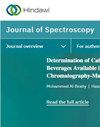Nano-Polyoxotungstate [Cu20P8W48] Immobilized on Magnetic Nanoparticles as an Excellent Heterogeneous Catalyst Nanoreactors for Green Reduction of Nitrophenol Compounds
IF 2.1
4区 化学
Q4 BIOCHEMICAL RESEARCH METHODS
引用次数: 0
Abstract
In this study, Cu20-polyoxotungstate [Cu20Cl(OH)24(H2O)12(P8W48O184)]25− supported on a magnetic substrate was used as a high-performance green method for the reduction of nitrophenol compounds such as 4-nitrophenol (4-NP) and 2,4,6-trinitrophenol (2,4,6-TNP). [Fe3O4@SiO2-NH2-Cu20P8W48] as heterogeneous magnetic nanocatalyst was synthesized and characterized by FT-IR, SEM, TEM, VSM, and TGA. This nanocatalyst has an excellent efficiency in the reduction of nitrophenol compounds to aminophenol compounds. The UV-Vis absorption spectrum is used at different times to evaluate the progress of the reaction. Under optimal conditions, 100% conversion and selectivity in reduction of 4-NP and 2,4,6-TNP to 4-AP and 2,4,6-TAP were obtained, respectively. In addition, after the reaction, the [Fe3O4@SiO2-NH2-Cu20P8W48] was recovered using an external magnetic field and used for the next cycle. The results showed that the nanocatalyst can perform eight consecutive cycles without any significant decrease in efficiency. In the end, according to the results, the proposed mechanism for this reaction was reported.磁性纳米颗粒固定化纳米多氧化钨酸盐[Cu20P8W48]绿色还原硝基酚类化合物
在本研究中,将cu20 -多氧钨酸盐[Cu20Cl(OH)24(H2O)12(P8W48O184)]25−负载在磁性衬底上,作为一种高效的绿色还原方法,用于还原4-硝基苯酚(4- np)和2,4,6-三硝基苯酚(2,4,6- tnp)等硝基酚类化合物。[Fe3O4@SiO2-NH2-Cu20P8W48]为非均相磁性纳米催化剂,并通过FT-IR、SEM、TEM、VSM和TGA对其进行了表征。该纳米催化剂在将硝基酚类化合物还原为氨基酚类化合物方面具有优异的效率。在不同时间用紫外-可见吸收光谱来评价反应的进展。在最佳条件下,4 - np和2,4,6- tnp还原为4- ap和2,4,6- tap的转化率和选择性分别为100%。此外,反应结束后,使用外部磁场回收[Fe3O4@SiO2-NH2-Cu20P8W48]并用于下一个循环。结果表明,该纳米催化剂可连续循环8次,效率无明显下降。最后,根据实验结果,提出了该反应的机理。
本文章由计算机程序翻译,如有差异,请以英文原文为准。
求助全文
约1分钟内获得全文
求助全文
来源期刊

Journal of Spectroscopy
BIOCHEMICAL RESEARCH METHODS-SPECTROSCOPY
CiteScore
3.00
自引率
0.00%
发文量
37
审稿时长
15 weeks
期刊介绍:
Journal of Spectroscopy (formerly titled Spectroscopy: An International Journal) is a peer-reviewed, open access journal that publishes original research articles as well as review articles in all areas of spectroscopy.
 求助内容:
求助内容: 应助结果提醒方式:
应助结果提醒方式:


